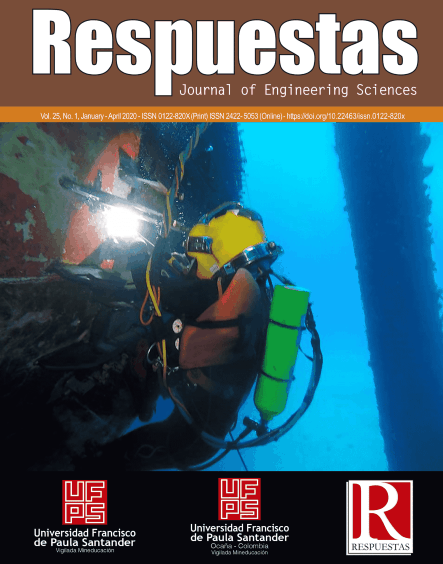Mechanical behavior of a hot micro agglomerate type MF-10 with recycled rubber grain
Comportamiento mecánico de un microaglomerado en caliente tipo MF-10 con grano de caucho reciclado
Main Article Content
In Colombia, different investigations of hot dense asphalt mixtures with recycled rubber grain mixtures have been carried out, however, it is the first time that the mechanical behavior of a micro agglomerate with GCR additions is analyzed due to the unusual application of this type of Mix in road works. The main objective of the research is to analyze the mechanical behavior of a hot micro agglomerate type MF-10, through the transformation of recycled rubber grain, characterize the materials used as the GCR and the modified asphalt type III, design micro agglomerates with and without connection of hot recycled rubber grain type MF-10 using the Marshall methodology with IDU 2011 specifications and determine the optimal percentage of recycled rubber grain for a micro agglomerate that has a better mechanical performance. For the investigation the Marshall methodology was used to design the different mixtures of micro agglomerates with and without additions of GCR, the verification tests thereof which are: Adhesion, plastic deformation, fatigue laws, resilient module, dynamic module and coefficient of slip resistance. With the addition of recycled rubber-GCR grain, the mechanical behavior of the asphalt mixture is improved by improving its useful life as well as contributing to the environment by recycling disused tires. An improvement of the mechanical behavior of the micro agglomerate is obtained in terms of increased adhesion, decreased hollowness, greater fatigue resistance, better resilient modulus and increased coefficient of slip resistance. The results of the research affected the design and construction of Colombia's roads, being its main use the rehabilitation of layers of rolling, having as an agent improving the mixture, the recycled rubber grain.
Downloads
Article Details
RONDÓN, H., REYES, F y OJEDA, B. Comportamiento de una mezcla densa de asfalto en caliente modificada con desecho de policloruro de vinilo (PVC). Ciencia e Ingeniería Neogranadina. Volumen (18-2), pp. 29-43. (2008). doi: https://doi.org/10.18359/rcin.1487
RPNDÓN, H., RUGE, J., PATIÑO, D., VACCA, H., REYES, F. y de FARÍAS, M. Escoria de alto horno como sustituto de la fracción fina de agregados en una mezcla de asfalto. Revista de Materiales en Ingeniería Civil. Volumen (30-10). (2018). doi: https://doi.org/10.1061/(ASCE)MT.1943-5533.0002409
OCAMPO, M., CAICEDO, B. y GONZÁLEZ, D. Mezclas asfálticas mejoradas con caucho molido proveniente de llantas usadas. Universidad de Los Andes. Bogotá D.C., Colombia (2002).
LORÌA SALAZAR, Luis Guillermo. Formulación en laboratorio de microaglomerados discontinuos en caliente, etapa II. Costa Rica, 2005.
MURAT KARACASU, VOLKAN OKUR, AND ARZU ER, “A Study on the Rheological Properties of Recycled Rubber-Modified Asphalt Mixtures, “The Scientific World Journal, vol. 2015, Article ID 258586, 2015.
MINISTERIO DE FOMENTO. MINISTERIO DE MEDIO AMBIENTE. CENTRO DE ESTUDIOS Y EXPERIMENTACIÓN DE OBRAS PÚBLICAS. Manual de empleo de neumáticos fuera de uso en mezclas bituminosas. España, 2007.
VARGAS, B., Sergio. Introducción a la tecnología de los microaglomerados en frío y discontinuos en caliente. Universidad de Chile. Facultad de ciencias, física y matemáticas. Departamento de Ingeniería civil, Chile. 2000
INSTITUTO DE DESARROLLO URBANO. Especificaciones técnicas generales de materiales y construcción para proyectos de infraestructura vial y de espacio público. Bogotá, IDU, 2011. Sección 202-11. Cemento asfaltico modificado con polímeros.
DIAZ CLAROS, César Mauricio y CASTRO CELIS, Liliana Carolina. Implementación del grano de caucho reciclado (GCR) proveniente de llantas usadas para mejorar las mezclas asfálticas y garantizar pavimentos sostenibles en Bogotá. Monografía de grado Ingeniero Civil. Bogotá D.C.: Universidad Santo Tomás. Facultad de ingeniería, Ingeniería civil, 2017
RODRÍGUEZ, Ellen. Uso de polvo de caucho de llanta en pavimentos asfalticos. Boletín técnico. PITRA-Lanamme. UCR. Costa Rica. 2016
DUEÑAS, Ana María y CALUME, Sinuhe. Recopilación y análisis sobre el uso del grano de caucho modificado (GCM) para la utilización por vía seca en el diseño de carpetas asfálticas en Bogotá. Monografía Ingeniero Civil. Bogotá D.C., Universidad Santo Tomas,
UNIVERSIDAD DE LOS ANDES. Estudio de las mejoras mecánicas de mezclas asfálticas con desechos de llantas-pista de prueba. Informe final contrato IDU-366-01. Alcaldía Mayor de Bogotá D.C. 2002
RODRÍGUEZ, Ellen. Uso de polvo de caucho de llanta en pavimentos asfalticos. Boletín técnico. PITRA-Lanamme UCR. Costa Rica. 2016.







